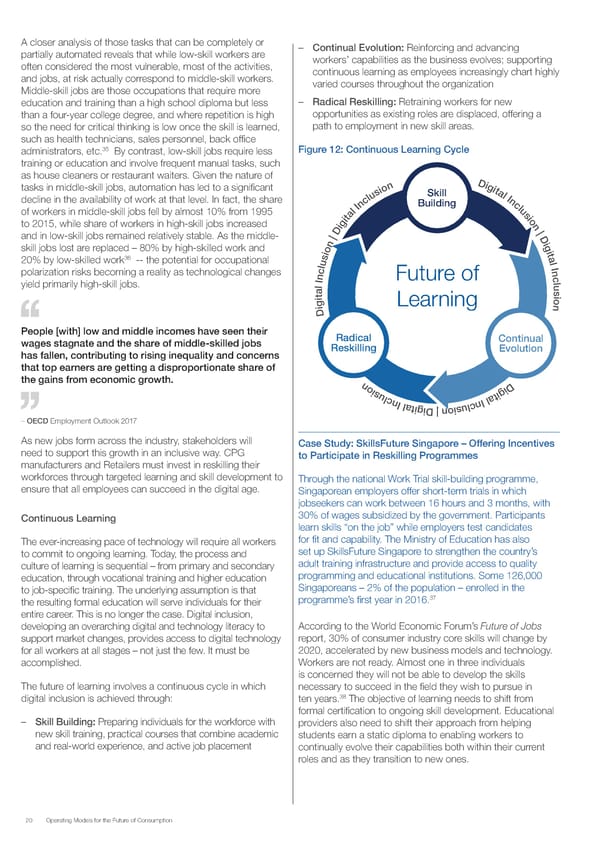A closer analysis of those tasks that can be completely or – Continual Evolution: Reinforcing and advancing partially automated reveals that while low-skill workers are workers’ capabilities as the business evolves; supporting often considered the most vulnerable, most of the activities, continuous learning as employees increasingly chart highly and jobs, at risk actually correspond to middle-skill workers. varied courses throughout the organization Middle-skill jobs are those occupations that require more education and training than a high school diploma but less – Radical Reskilling: Retraining workers for new than a four-year college degree, and where repetition is high opportunities as existing roles are displaced, offering a so the need for critical thinking is low once the skill is learned, path to employment in new skill areas. such as health technicians, sales personnel, back office 35 Figure 12: Continuous Learning Cycle administrators, etc. By contrast, low-skill jobs require less training or education and involve frequent manual tasks, such as house cleaners or restaurant waiters. Given the nature of D tasks in middle-skill jobs, automation has led to a significant n ig o it si Skill a u l I decline in the availability of work at that level. In fact, the share cl n n Building c of workers in middle-skill jobs fell by almost 10% from 1995 l I lu a s t io to 2015, while share of workers in high-skill jobs increased gi n Di | and in low-skill jobs remained relatively stable. As the middle- | D skill jobs lost are replaced – 80% by high-skilled work and n ig o i i t 36 s a 20% by low-skilled work -- the potential for occupational l u polarization risks becoming a reality as technological changes ncl Future of Inc I lu yield primarily high-skill jobs. l a is t igi Learning no D People [with] low and middle incomes have seen their Radical Continual wages stagnate and the share of middle-skilled jobs Reskilling Evolution has fallen, contributing to rising inequality and concerns that top earners are getting a disproportionate share of the gains from economic growth. noi giD s ulc I lati nI latigiD | noisulcn – OECD Employment Outlook 2017 As new jobs form across the industry, stakeholders will Case Study: SkillsFuture Singapore – Offering Incentives need to support this growth in an inclusive way. CPG to Participate in Reskilling Programmes manufacturers and Retailers must invest in reskilling their workforces through targeted learning and skill development to Through the national Work Trial skill-building programme, ensure that all employees can succeed in the digital age. Singaporean employers offer short-term trials in which jobseekers can work between 16 hours and 3 months, with Continuous Learning 30% of wages subsidized by the government. Participants learn skills “on the job” while employers test candidates The ever-increasing pace of technology will require all workers for fit and capability. The Ministry of Education has also to commit to ongoing learning. Today, the process and set up SkillsFuture Singapore to strengthen the country’s culture of learning is sequential – from primary and secondary adult training infrastructure and provide access to quality education, through vocational training and higher education programming and educational institutions. Some 126,000 to job-specific training. The underlying assumption is that Singaporeans – 2% of the population – enrolled in the 37 the resulting formal education will serve individuals for their programme’s first year in 2016. entire career. This is no longer the case. Digital inclusion, developing an overarching digital and technology literacy to According to the World Economic Forum’s Future of Jobs support market changes, provides access to digital technology report, 30% of consumer industry core skills will change by for all workers at all stages – not just the few. It must be 2020, accelerated by new business models and technology. accomplished. Workers are not ready. Almost one in three individuals is concerned they will not be able to develop the skills The future of learning involves a continuous cycle in which necessary to succeed in the field they wish to pursue in digital inclusion is achieved through: 38 ten years. The objective of learning needs to shift from formal certification to ongoing skill development. Educational – Skill Building: Preparing individuals for the workforce with providers also need to shift their approach from helping new skill training, practical courses that combine academic students earn a static diploma to enabling workers to and real-world experience, and active job placement continually evolve their capabilities both within their current roles and as they transition to new ones. 20 Operating Models for the Future of Consumption
 Operating Models for the Future of Consumption Page 19 Page 21
Operating Models for the Future of Consumption Page 19 Page 21